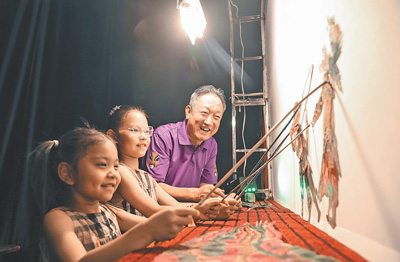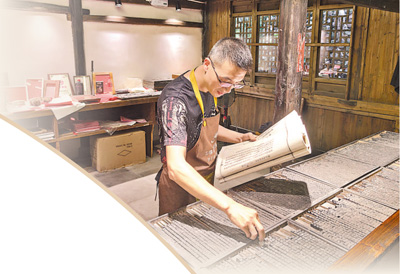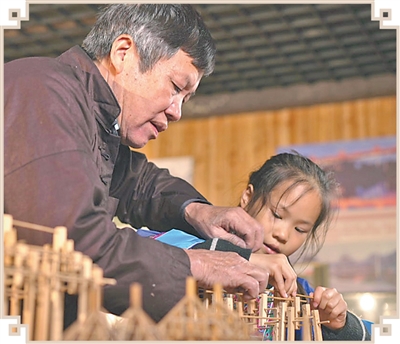




- BRNN
- BRI News
- BRNN News
- Database
Official Documents Polices and Regulations
Inter-government Documents International Cooperation BRI Countries
Business Guide Economic Data BRI Data
Trade
Investment Projects Latest projects
Cases - Content Pool
China's intangible cultural heritages have gained renewed vitality thanks to generations of inheritors who have upheld tradition while embracing innovation.
Across the vast land of China, many intangible cultural heritage inheritors combine fine traditional Chinese culture with the demands of modern life, using time-honored crafts to capture younger generations' hearts while effectively promoting the protection, utilization, inheritance, innovation, and dissemination of intangible cultural heritage resources.

Hou Jianchuan performs Xiaoyi shadow puppetry together with children. (People's Daily Online/Wang Fan)
Hou Jianchuan, 64, is an inheritor of Xiaoyi shadow puppetry in Xiaoyi city, north China's Shanxi Province. Traditional Xiaoyi shadow puppetry employed hemp paper-covered windows as screens, used sesame oil lamps for illumination, featured puppets carved entirely from the hide of cattle, and relied mainly on small suona horns as musical instruments. By the 1990s, only a handful of elderly performers could present the full repertoire of Xiaoyi shadow puppetry, including Wu Haitang, seventh-generation inheritor of the "Eryiyuan" shadow puppet troupe.
Hou became Wu's disciple, determined to preserve Xiaoyi shadow puppetry for future generations.
In 1996, he established the Xiaoyi shadow puppet and marionette arts research association, recruiting veteran craftsmen and new students while organizing scripts and holding rehearsals, gradually gaining fame.
Recent years have witnessed a thriving cultural tourism market in Shanxi, with scenic areas becoming new stages for intangible cultural heritage performances. Since 2010, Hou has collaborated with the Yungang Grottoes scenic area in Datong city, providing Xiaoyi shadow puppetry with a permanent performance venue.
In recent years, Hou has devoted more energy to cultivating new talents, serving as a visiting professor and instructor at multiple universities and colleges.
He compiled a nearly 300-page manuscript on Xiaoyi shadow puppetry knowledge. "This represents over 30 years of my dedication. I'm looking forward to publication opportunities to inspire more people to understand shadow puppetry," he said.
Wang Fawan, 52, hails from Dongyuan village in Wenzhou, east China's Zhejiang Province, and serves as an inheritor of wooden movable-type printing.

Wang Fawan selects Chinese characters for wooden movable-type printing. (Photo courtesy of the interviewee)
Wedding certificates created using traditional wooden movable-type printing techniques have gained popularity among young people, becoming sought-after creative cultural products, Wang said.
He added that intangible cultural heritage techniques must be integrated into modern life for better inheritance.
Wang has also embraced live streaming as a way to promote creative cultural products inspired by wooden movable-type printing, including refrigerator magnets, keychains, and seals, as well as newly launched items like desk lamps and puzzles.
"Promoting these creative cultural products allows us to connect with young people and spark new ideas," Wang said, adding that while the internet has challenged wooden movable-type printing, it has also brought new opportunities.
In 2017, Wang first brought wooden movable-type printing beyond his home province, establishing an educational tour center at a scenic area in central China's Henan Province. Since then, he has opened over 10 wooden movable-type printing experience centers across various places. Additionally, Wang has incorporated elements of wooden movable-type printing into architectural background walls and exhibition halls.
In May, Wang gave a lesson on wooden movable-type printing at Chongqing Foreign Language School in southwest China's Chongqing Municipality and donated wooden movable-type printing sets to the school so that students can try their hands on the craft more conveniently.
"We need to help more young people understand and appreciate this intangible cultural heritage craft," Wang said. He hopes to visit 100 primary and secondary schools within three to five years, allowing more children to experience the charm of fine traditional Chinese culture through donating teaching materials and tools and giving lectures.
Yang Siyu, 70, is an inheritor of the construction techniques of the wooden-structure buildings of the Dong ethnic group in Sanjiang Dong Autonomous County, south China's Guangxi Zhuang Autonomous Region.

Yang Siyu instructs his granddaughter to build a wooden-structure building model. (Photo/Yang Xiaolei)
Over five decades, he has overseen construction and restoration of more than 100 traditional Dong wooden structures, including drum towers, wind-and-rain bridges, and opera stages.
In 2002, the county planned to construct a landmark drum tower, publicly soliciting design proposals. After comprehensive comparison, Yang's proposal was selected. Over the past 20-plus years, this 42.6-meter-tall drum tower has become a local landmark.
Yang's wooden buildings are built using the mortise-and-tenon joints of traditional Chinese architecture. He has mastered over 100 types of mortise-and-tenon joints.

Tel:86-10-65363107, 86-10-65368220, 86-10-65363106